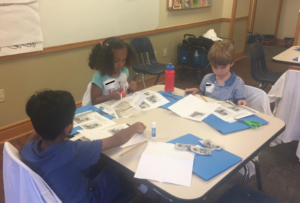Summer SAVY 2018: Session 2, Day 2 – Animal Adaptations (Rising 1st)
Happy Second Day!
Today the students continued their work toward earning their Scientific Investigator Certificate by thinking as scientists, particularly zoologists. Students began their day showing off their knowledge of change by illustrating five ways in which a tree could change. This led to a discussion about the meaning of life cycles. They learned that a life cycle means the developmental changes of an organism. They used the investigative process of “making observation, learning more, and creating meaning” to examine the life cycle of a plant and a frog. They watched a short video clip on how a frog adapts to living in the water and on land. Students started a daily journal on various animals and their adaptations to the environment. Ask your student what animal he/she journaled about! During whole group discussion, they rationalized that the life cycle process is a “change that is predictable” because it happens without any human interference.
Students also continued to test their understanding of safety rules and how to properly conduct experiments by preparing their mealworms’ habitats. We used magnifying glasses to carefully observe mealworms, measure them to the nearest millimeter, and recorded data. We took a nature walk to explore the generalization that “change may be natural or manmade” and reflected in journals that the life cycle (metamorphosis) of a mealworm is a change that is natural. Tomorrow the students will continue to observe their mealworms and document how the mealworms are adapting to their new habitats. I hope they’ll be looking forward to beginning a discussion on the difference between striving and/or thriving in ones environment and beginning to design the outer structures for their mealworm habitats!
Sincerely,
Dr. P.
Home Activities (optional):
What is the difference between striving and thriving in one’s environment?
Identifying the Steps of an Experiment

